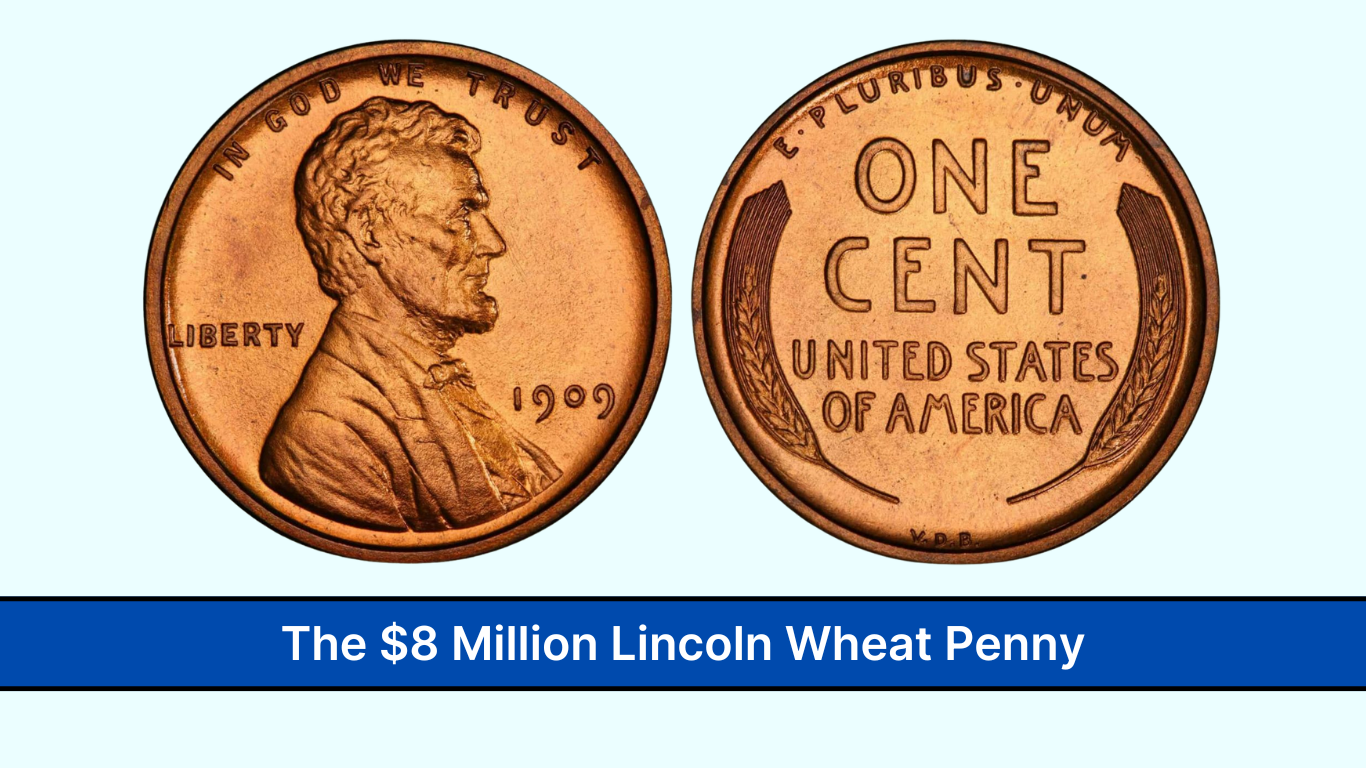Imagine finding a simple copper penny in your pocket, only to discover it’s worth $8 million. While it may seem like a fantasy, this is exactly what happened with the legendary 1943 copper Lincoln Wheat Penny—one of the rarest and most valuable coins in American history. This extraordinary coin serves as a reminder that hidden treasures can sometimes be found in the most unexpected places.
In this article, we’ll explore the fascinating history of the Lincoln Wheat Penny, the wartime mistake that created the 1943 copper penny, and other rare pennies that could be worth a fortune.
The Birth of an American Icon: The Lincoln Wheat Penny
The Lincoln Wheat Penny debuted in 1909 to honor the 100th anniversary of Abraham Lincoln’s birth. Designed by Victor D. Brenner, it was the first U.S. coin to feature a real historical figure instead of Lady Liberty.
Key Features of the Lincoln Wheat Penny (1909–1958):
- Obverse (Front): A portrait of President Lincoln
- Reverse (Back): Two wheat stalks framing the words “ONE CENT” and “UNITED STATES OF AMERICA”
- Material: Made of 95% copper (except for 1943, when steel was used)
For nearly five decades, these pennies were part of daily life, until they were replaced by the Lincoln Memorial design in 1959. However, certain rare versions remain highly valuable today.
The 1943 Copper Penny: A Wartime Mistake Worth Millions
During World War II, copper was in high demand for military supplies like ammunition and electrical wiring. To conserve this essential metal, the U.S. Mint switched from copper to steel in 1943, coating the new pennies with zinc to prevent rusting.
However, a few copper blanks from 1942 were mistakenly left in the minting machines and were struck with the 1943 date. These accidental copper pennies—estimated to be fewer than 20 in existence—became one of the most valuable coins ever produced.
Why Is the 1943 Copper Penny Worth So Much?
- Extremely Rare – Only a handful are known to exist.
- Historical Significance – A direct result of wartime rationing.
- High Demand – Collectors are willing to pay millions for one.
Notable Sales of the 1943 Copper Penny:
- $1.7 million – A high-grade example sold in 2010.
- $8 million – A recent private sale set a new record.
How to Identify a 1943 Copper Penny
If you suspect you have a 1943 copper penny, here’s how to check:
Check the Date: The year 1943 should be clearly visible.
Test with a Magnet: A genuine copper penny won’t stick to a magnet, while the common steel version will.
Weigh the Coin:
- Copper penny: 3.11 grams
- Steel penny: 2.7 grams
If your coin passes these tests, you may have found an extremely valuable piece of history. It’s crucial to get it authenticated by a professional grading service like PCGS or NGC.
Other Valuable Lincoln Wheat Pennies
While the 1943 copper penny is the most famous, several other Lincoln Wheat Pennies are worth thousands—or even hundreds of thousands—of dollars.
1. 1909-S VDB Lincoln Penny – Worth Over $100,000
This was the first Lincoln Wheat Penny, but controversy over the large “VDB” initials of designer Victor D. Brenner led to a quick design change. Only 484,000 were minted in San Francisco, making this coin highly sought after.
Look for: The “S” mint mark below the date and “VDB” initials on the reverse.
2. 1914-D Lincoln Penny – Valued Over $5,000
The 1914-D (Denver Mint) penny had a low mintage of just 1.2 million, making it one of the rarest regular-issue pennies.
Look for: A clear “D” mint mark beneath the date.
3. 1955 Doubled Die Lincoln Penny – Worth $1,000 to $125,000
A minting error in 1955 caused a dramatic doubling of the design, making the text and numbers appear as though they were printed twice.
Look for: A noticeable doubling of the letters in “LIBERTY” and “IN GOD WE TRUST.”
4. 1944 Steel Penny – Worth Over $100,000
In 1944, the U.S. Mint switched back to copper pennies, but a few leftover steel blanks were mistakenly used. These 1944 steel pennies are among the rarest coins ever struck.
Check the Weight: Steel pennies weigh 2.7 grams, while copper pennies weigh 3.11 grams.
Protecting Yourself from Counterfeits
Due to the high value of rare pennies, many counterfeits exist. If you believe you’ve found a valuable coin, take these precautions:
Avoid Online Scams: Buy and sell only through reputable dealers.
Use Simple Tests: A magnet test can quickly rule out a fake 1943 copper penny.
Get Professional Grading: Use trusted services like PCGS (Professional Coin Grading Service) or NGC (Numismatic Guaranty Corporation) to verify authenticity.
The Excitement of Coin Hunting
What makes coin collecting so thrilling is the possibility of finding a rare treasure in everyday life. While the odds of finding an $8 million penny are slim, people continue to discover valuable coins in:
Old piggy banks
Inherited coin collections
Loose change from everyday transactions
The thrill of the hunt is what keeps numismatists and collectors searching, hoping to uncover the next million-dollar penny.
FAQs About Rare Lincoln Pennies
Check if it’s magnetic (steel) or non-magnetic (copper). A non-magnetic 1943 penny is extremely rare and valuable.
Yes! While rare, some 1955 Doubled Die or 1909-S VDB pennies can still turn up in old collections.
For high-value coins, get them authenticated by PCGS or NGC and sell through reputable auction houses like Heritage Auctions or Stack’s Bowers.
Verify authenticity using weight and magnet tests.
Have it graded by a professional service.
Consider selling through a trusted auction or coin dealer.
Factors like rarity, minting errors, historical significance, and collector demand drive the price of certain Lincoln pennies into the millions.

